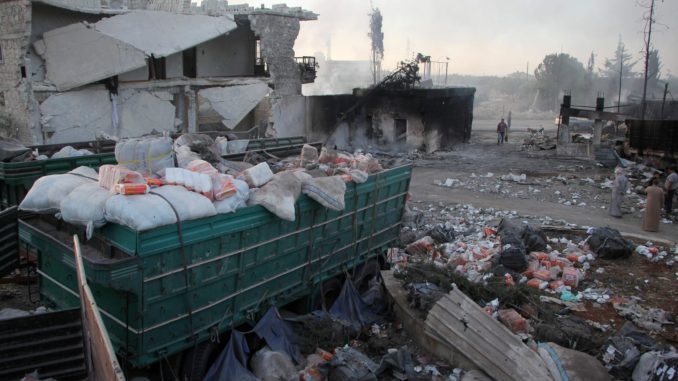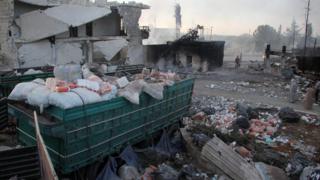
Syria conflict: Aid convoy attack was air strike, UN expert says
-
5 October 2016
- From the section Middle East
 Image copyright
Image copyright
AFP
The UN’s secretary general denounced the attack as “savage and apparently deliberate”
Analysis of satellite imagery taken after a deadly attack on an aid convoy in northern Syria last month shows that it was an air strike, a UN expert says.
At least 18 people were killed when lorries unloading at a Syrian Arab Red Crescent warehouse in a rebel-held town outside Aleppo came under fire.
The US believes Russian warplanes bombed the convoy. Russia, which backs Syria’s government, denies the charge.
UN officials have said the incident could constitute a war crime.
Secretary General Ban Ki-moon has established an internal board of inquiry to investigate the attack, which he has denounced as “sickening, savage and apparently deliberate”.
- Convoy attack: What we know
- Reporting Syria: The images you won’t see
- The seven-year-old tweeting from Aleppo
- How Moscow’s Syria campaign has paid off
The UN says that on the evening of 19 September, 31 lorries delivering life-saving aid to a SARC warehouse in Urum al-Kubra came under fire.
The head of the SARC in the town was among those killed, while 18 of the lorries were totally destroyed. The warehouse and a nearby medical clinic were also severely damaged.
UN officials have so far referred to the incident only as an “attack” and not accused any of the warring parties of responsibility.
But on Wednesday, Lars Bromley, research adviser at the UN Operational Satellite Applications Programme (Unosat), told a news briefing in Geneva: “With our analysis we determined it was an air strike and I think multiple other sources have said that as well.”
Image copyright
Reuters
Pictures of the scene appeared to show at least one crater in the floor of the aid warehouse
“For air strikes, what you are usually looking at is the size of the crater that is visible, and the type of crater,” he added.
“Basically air-dropped munitions are often much larger than anything you would fire from the ground.”
The chairman of the US military’s Joint Chiefs of Staff, Gen Joseph Dunford, told a Senate Committee three days after the attack that two Russian warplanes had been in that area at the time, along with some “some other aircraft” belonging to the Syrian government.
“There’s no doubt in my mind that the Russians are responsible. I just don’t know whose aircraft actually dropped the bomb,” he said, calling the incident “an unacceptable atrocity”.
Russia’s defence ministry, which has vigorously denied the charge, initially said videos of the aftermath of the attack did not show any evidence that the convoy had been struck by air-dropped ordnance.
But it subsequently said a US Predator drone had been flying above Urum al-Kubra at the time of the attack – an allegation the US military quickly dismissed.
Unosat also released satellite images that Mr Bromley said showed “an awful lot of new damage” to rebel-held areas of the city of Aleppo, on which government forces launched an all-out assault after a truce brokered by the US and Russia collapsed two weeks ago.
Hundreds of air strikes – some allegedly involving bunker-busting, incendiary and cluster munitions – have killed at least 420 people and injured more than 1,000 others since then.
“The areas that are being bombed have been bombed almost continuously for quite some time. So seeing dramatic images of formerly pristine areas now turned to rubble – you don’t see a lot of that,” Mr Bromley said.
